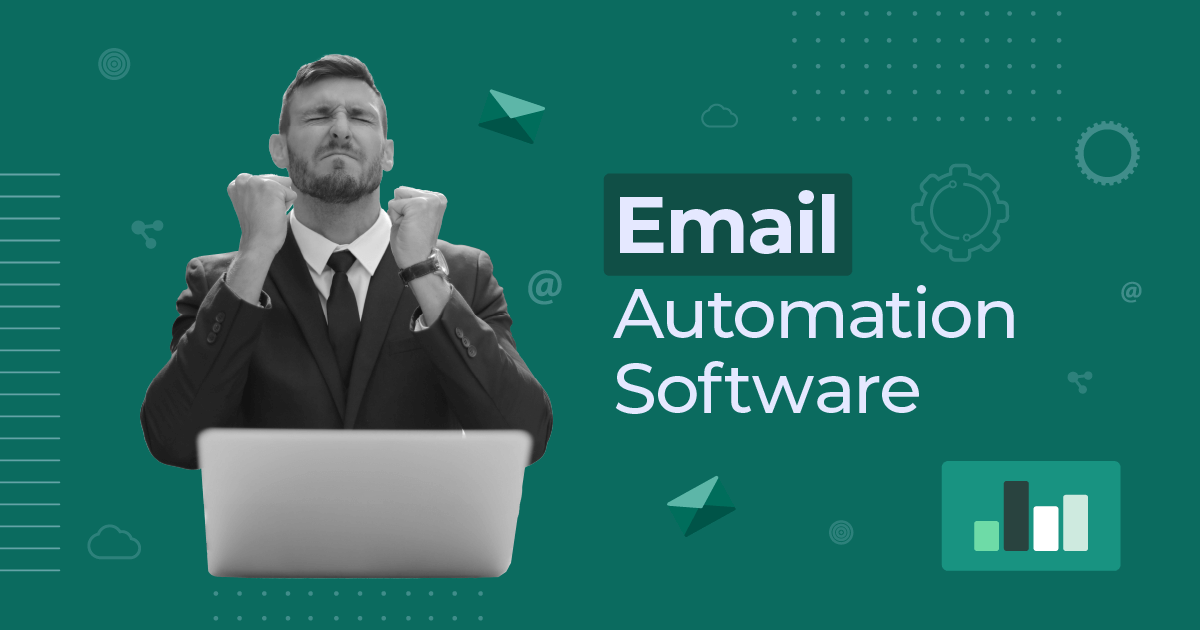
How to Evaluate And Choose New Email Software [2025]
After evaluating your current email marketing tool and determining it no longer meets your needs, it’s time to explore new options.
In our previous post, we guided you through the evaluation process to identify the limitations of your current software. Now, we’ll take the next step by helping you evaluate the alternatives you’ve discovered.
With so many email marketing tools available, choosing the right one can be overwhelming. Our guide will provide you with tips and strategies to evaluate and choose email software that better suits your needs.
Missed the first step? You can put your current tool under the microscope by visiting our how to change your current email software guide.
Why You Should Evaluate Your Potential Email Tools
Evaluating your potential email tools before making a commitment is crucial for several reasons.
- Feature compatibility: Ensure the tool meets your specific business needs like automation, segmentation, and analytics.
- Cost-effectiveness: Get the best value for your money without paying for unnecessary features.
- Deliverability: Find the one with high deliverability rates to ensure your emails reach your audience’s inboxes.
- User experience: Check how user-friendly the tool is how easily your team will adopt it.
- Integrations: See if the tool integrates smoothly with your existing systems like CRM and eCommerce platforms.
- Scalability: Pick the tool that’ll grow with your business, accommodating future needs without switching platforms.
- Support and resources: Get the platform with robust customer support and resources to help you when needed.
Advanced features or affordable price?
No need to compromise. Get premium functionality and unlimited emails from $9/month.
Switch to Moosend
Checking your potential email tools thoroughly helps you make an informed decision, leading to better email marketing outcomes and a more efficient workflow.
Now let’s see how to evaluate them.
1. Include the Right People in the Conversation
Depending on the size of your organization, you can put a team together to help you with your decision. The main people to include should be:
- Representatives of the team members who will use the email software day-to-day.
- A member of your IT team who can track the required system changes for implementation, ensuring there aren’t any clashes with existing systems and the deployment is seamless.
- Someone from your finance team to approve the new software’s expense.
Look for objective staff members who demonstrate commitment to quality and continuous improvement so you can be sure they will help choose the right email platform.
2. Understand Your Email Marketing Needs
Another crucial step to evaluate and choose email software correctly is to understand your business needs. This way, you’ll find the best platform for you, not something that everyone gets.
We’ve outlined some things different businesses should look for.
Email software for individual professionals
Solo professionals like entrepreneurs and freelancers need to look for the following features:
- Email list management
- Calendar integration
- Basic automation (like autoresponders)
- Subscription forms
Email software for small businesses
Small businesses have specific needs somewhere between solo professionals and marketing teams. A running theme is the goal of doing more with less.
The things to look out for in your email software include:
- Scalable pricing plans
- Email newsletter templates
- Integrations
- Landing page builder
- Robust customer support (like live chat, tutorials, or a knowledge base)
Platforms like Moosend offer templates for email content and landing page designss to help you kick off your email marketing efforts without paying for a designer or extra tools. Also, it’s a great option for SMBs that need advanced functionality without breaking the bank.
Further reading: Check out our blog post about the best email marketing software for small businesses to give you more insight ahead of your decision.
Email software for marketing teams
Marketing teams need to focus more on producing a high-volume email marketing strategy. You should look for:
- Advanced automation workflows
- Audience segmentation
- A/B testing capabilities
- Detailed analytics
Email software for eCommerce stores
Ecommerce stores such as Shopify have a niche set of feature needs. Make sure your chosen platform offers:
- Transactional email automation
- Product recommendations
- Integration with eCommerce platform
3. Look Beyond the Price Tag
It may be tempting to go for free software or software that’s cheaper than the rest. However, the cheapest isn’t necessarily the best.
That’s not to say that a free or cheap platform won’t work for you—free plans can be great for helping you get off the ground, and cheap platforms with limited features can be ideal for companies that don’t need all the bells and whistles.
The problem is that most platforms have limited free plans, and you either won’t have access to many features or will only have a few days to use them before you need to pay.
It’s the same for cheap platforms which lack the advanced features of their pricier counterparts.
Instead of forcing your email strategies to fit the limitations of the platform you’ve settled for, do your research and look at reviews from people who have tried the software before you, to see if it will be a good fit for your needs, not just for your pocket.
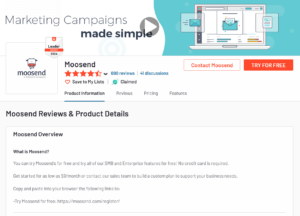
Review websites like G2 and Capterra are a great place to start. These sites allow genuine software users to leave reviews that indicate potential issues you might not spot during a trial, saving you time in the long run.
4. Know What Types of Emails You Want to Send
Choosing the right platform starts with knowing the types of email campaigns you plan to send. You must understand what your subscribers want and/or need to receive.
Those email types will vary from business to business, but they can be roughly categorized into transactional emails, drip campaigns, and newsletters.
Transactional emails
Transactional emails are sent to individual subscribers after they complete an action such as signing up for a newsletter or placing an order.
Every business will send some form of transactional email, so make sure that your chosen software can send them.
Finding an email platform that lets you customize your transactional emails is a great way to maximize their potential. Also, apart from sending improtant information (order details, etc.) you can use them to deliver product recommendations and other marketing communications.
Look for the following features if you will be sending transactional emails:
- Transactional email templates
- Customization options
- Deliverability
Drip campaigns
A drip campaign is a sequence of automated emails sent to a subscriber after they perform a specific action, such as creating an account on a new platform, or at a set time or date, like a few days before their next subscription box ships.
The emails can be used for onboarding, cross-selling, win-back campaigns, and much more.
Drip campaigns are so versatile that you will probably use one for your subscribers. Therefore, it’s important your email marketing software can build beautiful content for it and has the right automation capabilities.
You should also look for:
- Personalization features
- List segmentation capabilities
- Integrations
- Analytics and reporting
Further reading: Check out our drip email marketing guide for more information.
Newsletters
Email newsletters let brands share news, updates, promotion announcements, and blog posts, and showcase new features or products.
Many brands use them as a core part of email marketing, and they serve many purposes, so it’s important to evaluate and choose email software that has the capacity to create, automate and schedule them.
Features you should look for include:
- Ease of use
- Pre-made templates to speed up your email newsletter design process
- Segmentation features
All of the above
You’ll likely need to send some combination of all three types of emails, so you might want to look for email software with the right functionality for all three email campaigns rather than a niche one.
5. Consider Your Must-Have Features
Understanding your business needs is key to evaluating and choosing the right email software. Spend some time thinking about what you want to achieve with your email software and the features you need to help you do that.
Note down the essential features and the nice-to-haves, and remember that adding more features isn’t necessarily the best option, as you may end up paying for features you never use.
Identify dealbreakers early to disqualify the tools that don’t fit your criteria.
Depending on your needs, we’ve compiled some features you may consider must-haves.
Contact list management
Your contact list is how you build your email marketing strategies.
Most platforms allow you to store a contact’s email address and name, and some allow you to add more detailed information like birth date, physical address, or custom fields.
Look for software that has different functionalities for adding contacts, including manually, file import, or from subscription forms embedded on your website or landing page.
For example, Moosend has advanced audience management features that let you add tags to contacts, perform bulk actions, and add custom information for a truly personalized email experience.
Audience segmentation
List segmentation is an integral part of any good email marketing strategy. It lets you send highly personalized, targeted emails to specific groups of subscribers.
Most platforms offer basic segmentation that lets you create lists based on demographics like age, gender, and location, while others have more advanced segmentation features.
For example, Moosend’s segmentation features allow you to hyper-segment your list based on browsing history, past purchases, the time they viewed products, where they are in the customer journey, and more.
Email templates
A premade email template can save you time, money, and frustration if you’re not a designer. Most email platforms offer a range of pre-built templates that you can edit to fit your needs. And, they can help you ensure your email content is consistent in design and branding.
If you plan to use templates for your email content, look for a platform that offers templates for various types of email campaigns that you can easily customize.
Drag-and-drop email builder
Creating a beautiful, well-designed, and interactive email campaign sounds like a far-fetched dream if you don’t know how to code. Luckily, many email marketing software programs have a drag-and-drop email builder.
This lets you build custom emails with elements you can grab and drag to your desired location in the email.
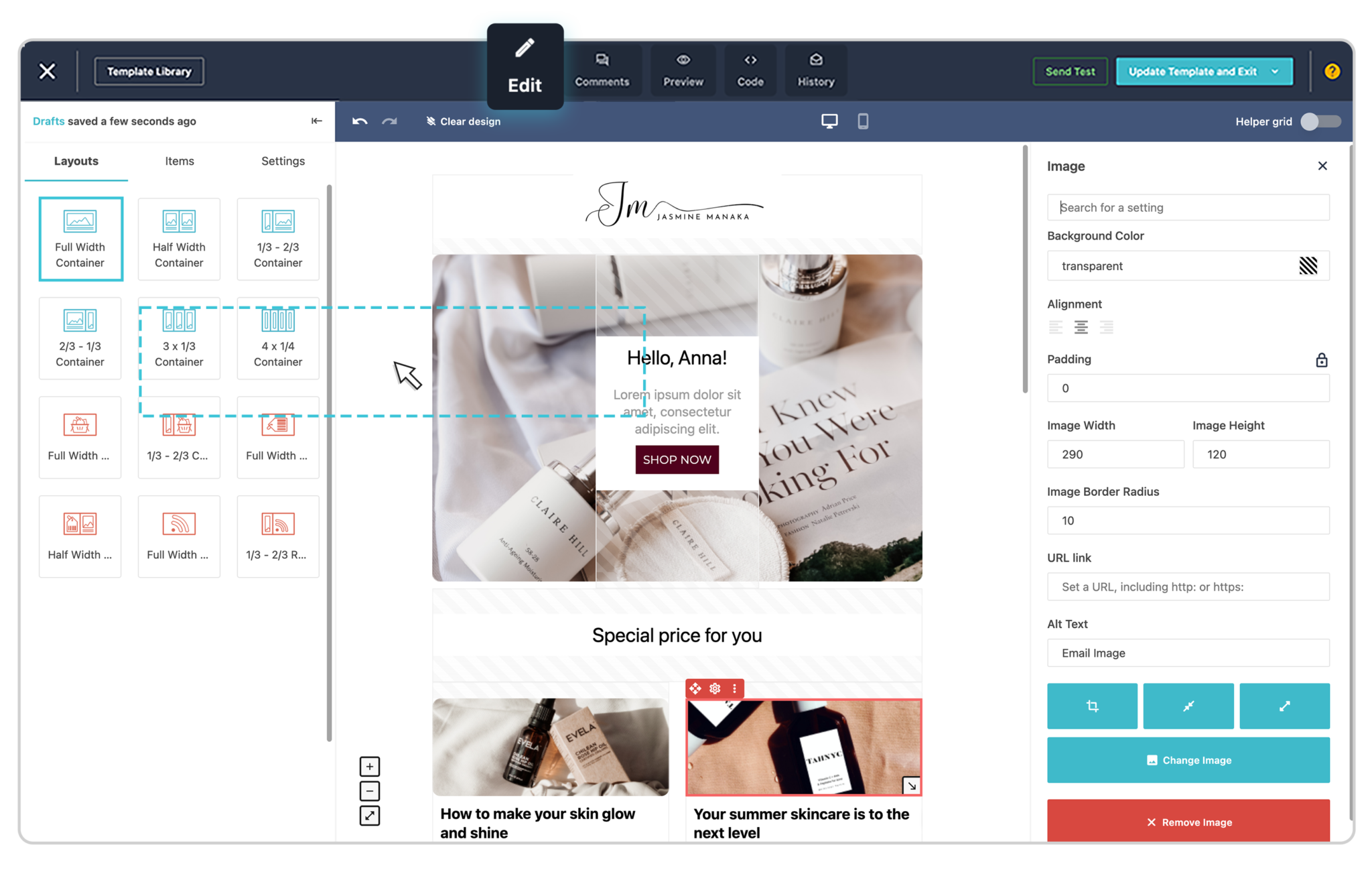
Moosend has different editor views, including the code and the drag-and-drop email builder, so no matter your preference and skill level, you can bring your email content dreams to life.
Email scheduling
It is crucial to get the timing of your email campaigns right, but it can mean sending emails at odd hours.
Most email services offer email scheduling so you can set up your emails in advance and schedule them to be sent at exactly the right moment.
Scheduling is also important for effective email automation, so it’s a key feature you should look for.
Simple automation functionality
Automated email marketing campaigns elevate your marketing efforts, and to set them up, you will need a platform with automation tools.
Email automation lets you send highly personalized content to your subscribers by setting up triggers, such as a welcome email when someone signs up for your newsletter or a cart abandonment reminder when they leave your site without making a purchase.
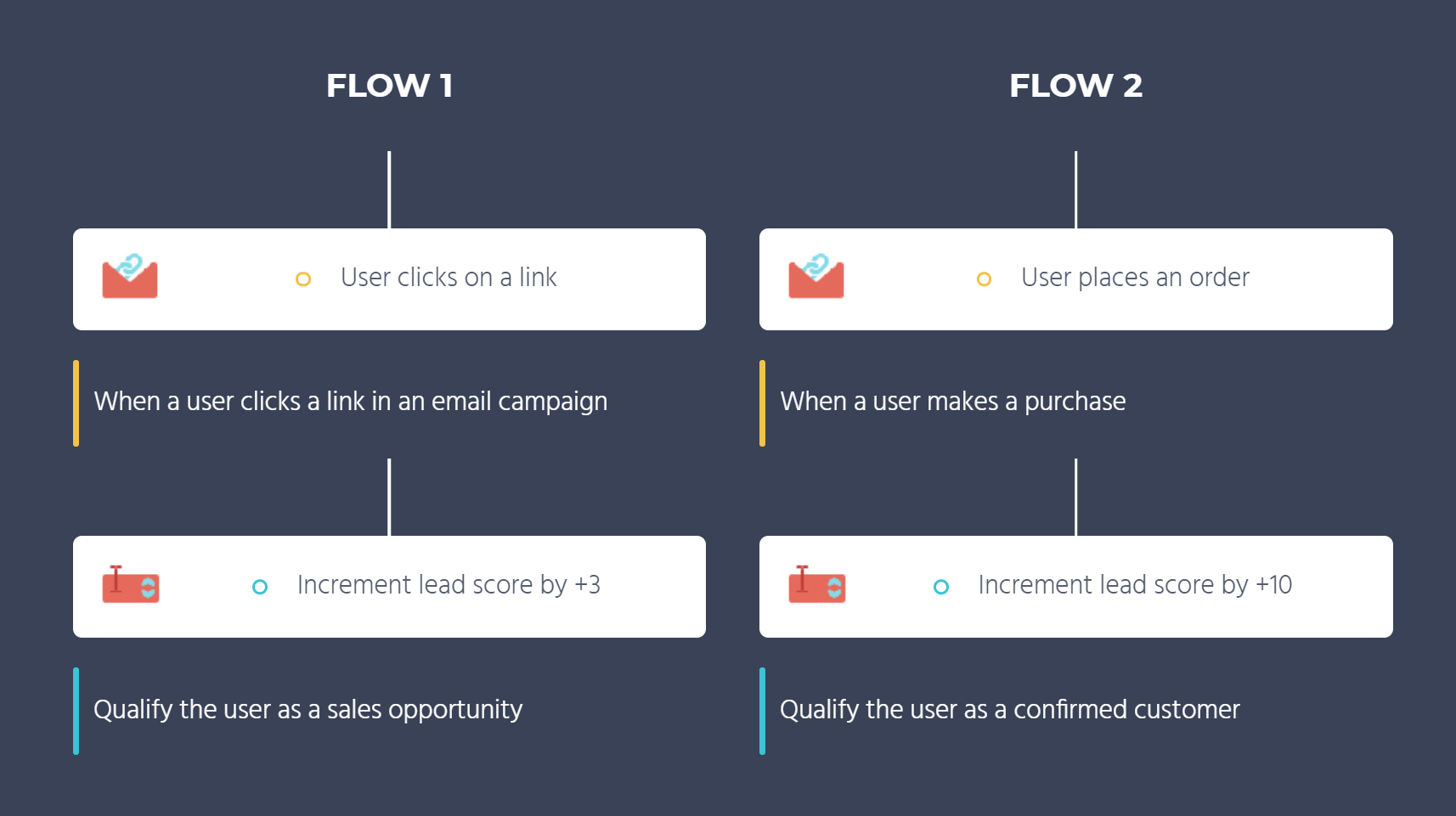
Platforms like Moosend have marketing automation features that let you set up workflows using pre-made “recipes” or design your automation sequence from scratch.
Insights and reporting
You will need to assess your email performance, so look for a platform that aggregates your data and lets you view key email metrics like open rate, click-through rate, conversion rate, bounce rate, and unsubscribe rate.
Using tracking features, you can collect all of the above-mentioned data, and with the reporting and analytics tools, you can combine the data into an easily digestible, shareable report.
Security and compliance
Ensuring compliance with regulations like GDPR and CAN-SPAM is vital as you will collect and process your subscribers’ sensitive personal data. Choosing an email platform that stores the data securely and follows all regulations is crucial.
Deliverability tools and reports
If you use an email platform with a low deliverability score, your hard work will likely go to waste, and your emails will end up in a spam folder.
Look for a reputable email service provider that provides thorough reports when an email is rejected so you can work on your deliverability.
Additionally, you can use numerous resources to evaluate and choose email software more objectively and efficiently.
For instance, you can check deliverability tests from credible sites such as EmailToolTester to ensure you’re choosing a reliable platform.
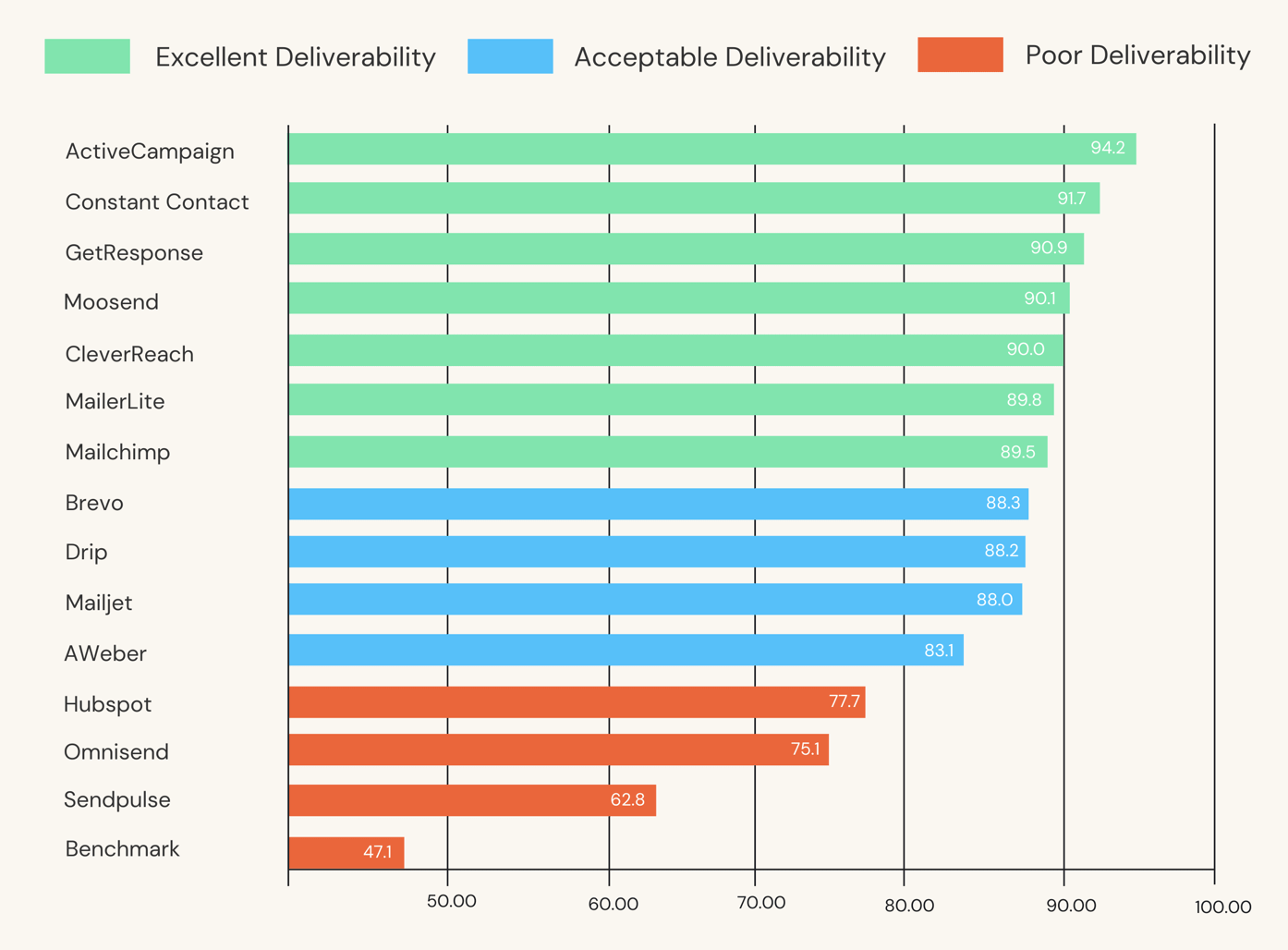
Built-in AI tools and functionalities
AI is rapidly becoming a key part of many different areas of our lives, and email marketing is no different.
Platforms with AI functionality can offer you more advanced processes in one tool, streamlining your operations, increasing productivity, and even reducing costs.
Moosend has email marketing AI features that help you generate email body copy and subject lines, and can transform your ideas into compelling narratives that resonate with your audience, enhancing engagement.
6. Think About the Future, Too
It’s worthwhile considering what features you might need in the next few years and ensuring your chosen platform has those capabilities so you can upgrade later.
When you evaluate and choose email software, here are a few ways you can assess a platform’s scalability.
Volume-based pricing
As your business grows, your customer base and, therefore, your email list will grow, too. That means you’ll send more and more emails.
Make sure the platform you’re considering offers scalable pricing so you can upgrade to higher packages as needed.
Advanced personalization features
Most marketing platforms will have basic personalization capabilities that let you insert the contact’s name into the subject line, but you can—and should—go much further than that, especially as your business grows.
Advanced automation
Automation is crucial for effective email marketing. While you may not need advanced automation initially, and you can probably get away with creating your own basic workflows, your needs will change as you grow.
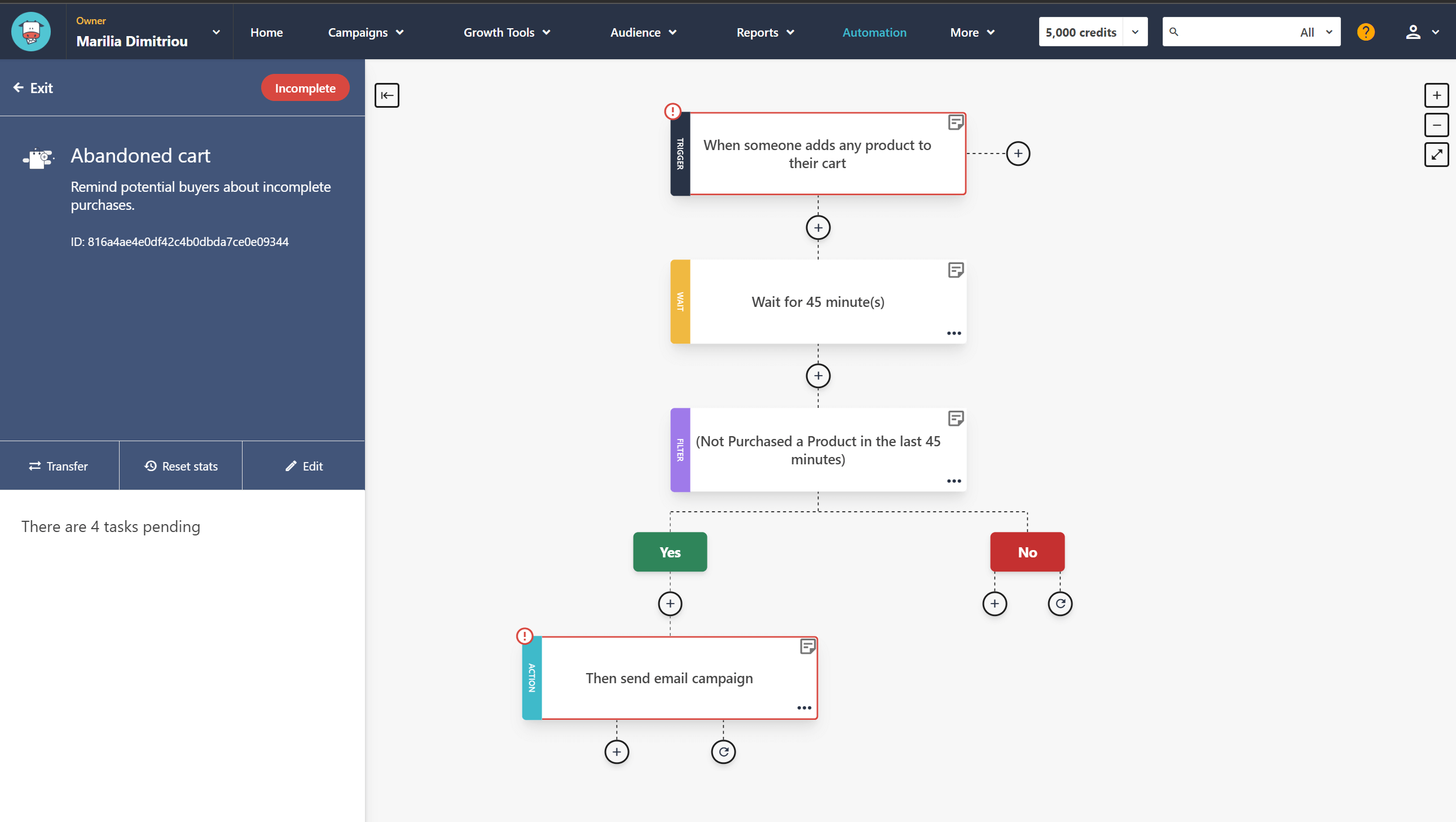
A platform like Moosend with advanced automation capabilities and pre-built templates is a saving grace for every email marketer. Plus, you can create your own workflows with multiple triggers, and/or expressions, and the ability to merge paths.
Ecommerce functionality
If you run an eCommerce store, it’s important to choose a platform that integrates with your eCommerce platform (Shopify, WooCommerce, etc.) for a more seamless email marketing approach.
An eCommerce-oriented tool will let you manage customer information from your store all in one spot so you can easily build segments that support targeted marketing and find what you need.
A/B testing
A/B testing is testing variations of elements within your emails to optimize them for your audience. It is ideal for ensuring the continuous improvement of your email marketing efforts.
If you want advanced insight into campaign performance, opt for a platform that offers deep analytics into contact behavior and sales reports.
Further reading: Read our blog post about A/B testing emails to learn the ropes!
Integrations
As your company grows, your marketing tech stack will grow too. It’s important to ensure your email marketing platform offers integrations with various platforms so you can integrate with your CRM, eCommerce store, CMS, and other tools you might be using.
Moosend integrates with a huge range of platforms, like WooCommerce, HubSpot, and Zendesk, and has an API, so your developers can integrate it themselves if your chosen tool isn’t on the list (yet).
7. Test Each Potential Choice Extensively
Send some test emails to your testing team, see how well you can add their email addresses to your contact list, and play around with all those features.
Make notes of what you liked and didn’t like so you can review them together at the end of your testing phase.
8. You Can Always Switch Apps Later
If you find after a few months that the platform you’re working with doesn’t fit your needs as well as you first thought, or if your needs evolve, you can always switch to a better fit.
You’ll need to migrate your data, but importing data from another tool isn’t too difficult. When you assess your app, make sure you check out its data migration features.
Additional Resources to Evaluate and Choose Email Software
To further assist you in evaluating and choosing your new email tool, we’ve compiled a selection of valuable resources.
Below, you’ll find detailed tool comparisons, in-depth reviews and more.
Email tool reviews:
- Mailchimp Review: Pros, Cons & Pricing [Analysis]
- Kit (formerly Kit) Review: Pros, Cons, Pricing
- Constant Contact Review: Pros, Cons, Ratings
- Brevo Review: Pros, Cons & Pricing
- MailerLite Review: Pros, Cons & Pricing [Analyzed]
Best tools per industry:
- Best Email Marketing Software For Small Businesses
- Best Email Marketing Software For Startups
- Best Email Marketing Software For Agencies
- Best Email Marketing Software For Ecommerce
- Best Enterprise Email Marketing Software Solutions
Popular tool alternatives:
- Mailchimp alternatives
- Brevo alternatives
- Constant Contact alternatives
- Klaviyo alternatives
- Kit (formerly Kit) alternatives
Invest in the Right Email Marketing Solution for Your Business
Choosing the right email marketing platform for your business can feel daunting at first. It is a big decision, after all, and there are a lot of options out there. That’s why it’s essential to evaluate and choose email software carefully.
By making sure you involve the right people, understand your email needs beyond price, consider your must-haves, and test each tool thoroughly, you can be sure you will make the right decision.
Now you can start evaluating the new email marketing tools you’ve found and be sure to consider Moosend. With advanced automation, detailed analytics, and user-friendly templates, Moosend can enhance your email marketing efforts. Sign up for free today to see what it has to offer.
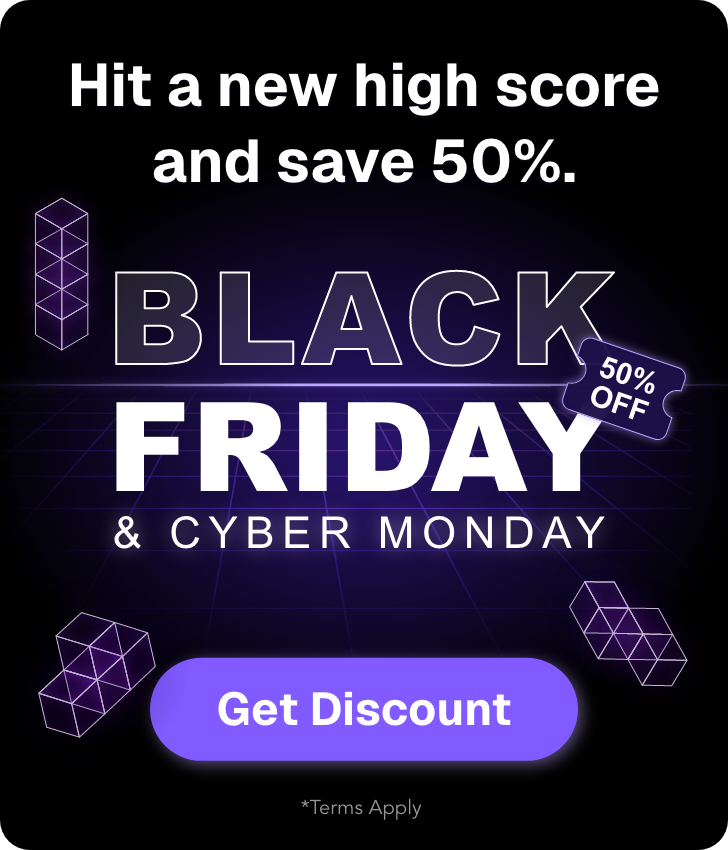


 Published by
Published by
